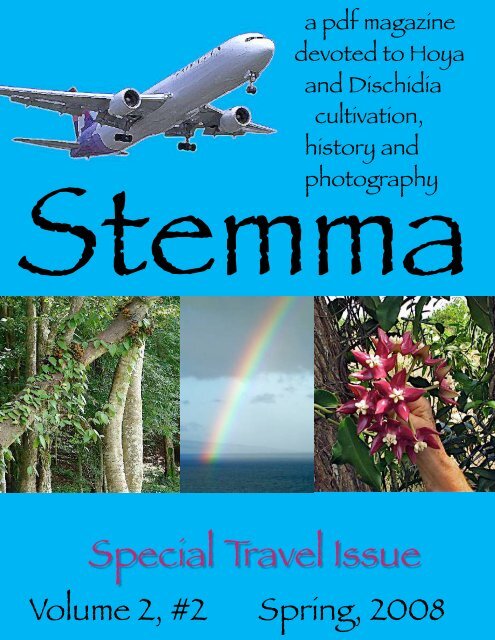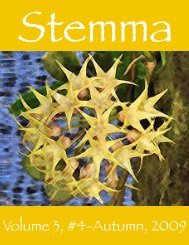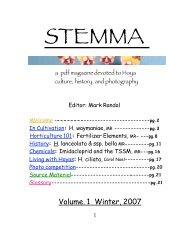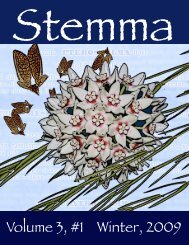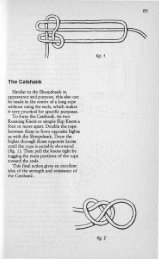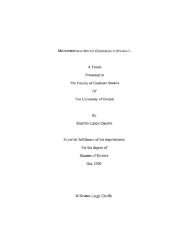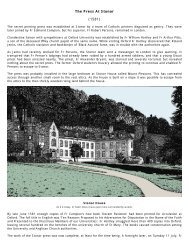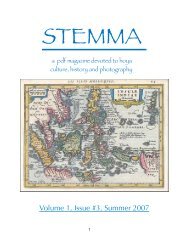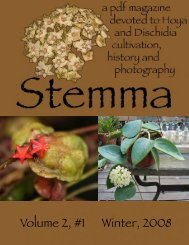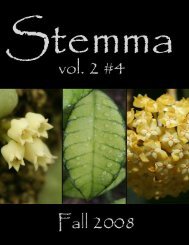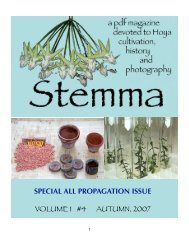You also want an ePaper? Increase the reach of your titles
YUMPU automatically turns print PDFs into web optimized ePapers that Google loves.
a pdf magazine<br />
devoted to Hoya<br />
and Dischidia<br />
cultivation,<br />
history and<br />
photography<br />
Stemma<br />
<strong>Special</strong> <strong>Travel</strong> <strong>Issue</strong><br />
Volume 2, #2<br />
1<br />
Spring, 2008
3 Editor's Note<br />
contents<br />
5 <strong>Travel</strong>: In Borneo by Carol Noel. Photos by Carol Noel<br />
and Ted Green.<br />
15 Reprint: Hoya imperialis Lindl. from Curtis’ Botanical Magazine<br />
18 <strong>Travel</strong>: In Thailand by Simone Merdon-Bennack.<br />
All photos by the author.<br />
25 Reprint: Hoya acuta Haw. (as H. pallida ) from the Botanical Register<br />
27 <strong>Travel</strong>: In the Philippines by Surisa Somadee. All photos by the author.<br />
39 Reprint: Hoya myrmecopa Kleijn & Donkelaar from Blumea 46<br />
41 Source Materials<br />
42 Back Page: Hoya sp. “flat stem” photos: Sutthisak Sangkhakorn, Merlin Sy<br />
and Chanin Thorut. Text: Mark Randal<br />
Editor: Mark Randal<br />
Editor of Dischidia Content: Antone Jones<br />
Technical Consultant: Bobby Fisher<br />
Stemma Godmother: Carol Noel<br />
Availability: Stemma is available through email delivery, but with a limit of three hundred<br />
subscriptions. Subscriptions are full at this time. The newest issue of Stemma will always<br />
be available as a download from the Epiforums website at : http://www.epiforums.com.<br />
Posting Stemma for download on unauthorized sites is prohibited. A rotating selection of<br />
past issues will be available at the Aloha Hoya website :<br />
http://www.bigislandgrowers.com/ghp/AH.php<br />
Usage Policy: Stemma may be distributed freely as a whole by private individuals, but<br />
content and photos remain the intellectual property of the individual contributor and may<br />
not be reproduced separately. Use of any portion of Stemma (including photographic<br />
content) for commercial gain is strictly prohibited.<br />
© Stemma Magazine 2008<br />
2
Editor’s Note<br />
This special edition was<br />
the result of a happy confluence of events. Three excellent travel articles were submitted<br />
to Stemma and ended up on our desks at around the same time early this spring.<br />
Surisa Somadee, a Thai Hoya aficionado, sent us a poetic account of her trip to the<br />
Philippines, where she visited with Dr. Monina Siar at UP Los Banos and Merlin Sy at his<br />
Pinoy Plants Nursery in Manila. Surisa is also working to establish a Thai Hoya society-<br />
see the next page for details.<br />
Simone Merdon-Bennack, a German national, sent in a thoughtful account of her recent<br />
travels in Thailand. Simone maintains a Hoya information website<br />
(http://www.simones-hoyas.de/) which is a wonderful resource, containing comprehensive<br />
accounts of most Hoya species’ publication and history.<br />
Carol Noel, of Aloha Hoya (http://www.bigislandgrowers.com/ghp/AH.php) and resident<br />
of Hawaii, provided a beautiful photo essay of a recent trip to Borneo led by Ted Green,<br />
also of Hawaii and owner of Green: Plant Research (http://www.rare-hoyas.com/).<br />
These articles present an excellent opportunity to Hoya growers in cooler climates to<br />
see Hoya and Dischidia in<br />
their natural environment,<br />
where they display a grace<br />
and character quite different<br />
from their appearance in cultivation.<br />
<strong>Special</strong> thanks to Christiaan<br />
Caspers for translation assistance<br />
and Gerbrand Caspers<br />
for encouragement on this<br />
issue.<br />
3<br />
Simone Merdon-Bennack (middle),<br />
Surisa Somadee (right), Uwe<br />
Merdon (left) in Thailand.
It seems that Hoya continue to grow in popularity in cultivation, as indicated by the<br />
increase in Hoya societies around the world. Despite the untimely demise of the AFAHO<br />
(featured in the last issue of Stemma), new societies are popping up on a regular basis. A<br />
new Romanian society has formed and created a well-designed website,<br />
(http://hoya.forumgratuit.ro/index.htm) with options for also communicating in English<br />
and French.<br />
A new Thai website www.thailandhoyaclub.com created by Stemma contributor Surisa<br />
Somadee, may form the basis of a new Thai Hoya society, the Thai Hoya Club. Good<br />
luck, Surisa!<br />
Featured here is the painting created by Kevin Mosley for the winner of the third and final<br />
Stemma photo contest, Torill Nyhuus. Sorry to have taken so long to get this project<br />
finished, Torill, but it is on its way to you now! n<br />
4
<strong>Travel</strong><br />
5<br />
In Borneo<br />
by Carol Noel<br />
photos by Carol Noel and Ted Green.
Borneo. Sabah.<br />
Kota Kinabalu. Rain forests,<br />
peat forests, cloud forests,<br />
exotic birds and butterflies.<br />
Mullahs calling the faithful<br />
to prayers starting at dawn<br />
and throughout the day…<br />
crystal blue skies, exotic architecture,<br />
abject poverty,<br />
new construction. Beauty.<br />
Hope….and Hoya.<br />
6<br />
Private collections of Hoya, Dischidia<br />
and Orchids mounted<br />
atop tree fern posts…growing<br />
wild. Hedges of hybrid Aranda<br />
Orchids with their faint sweet<br />
fragrance (above).<br />
Hoya waymaniae growing in<br />
very little shade with HUGE<br />
leaves (left).<br />
Photos:<br />
Title page: Gunong, Mt. Kinabalu,<br />
looking north: TG.<br />
Above: CN<br />
Left: TG
7<br />
Tony Lamb (right) and Ted Green<br />
with Hoya lambii.<br />
Photo: CN<br />
A tiny Dischidia with miniscule<br />
flowers (left).<br />
Photo: TG
Drove to an area near the beach. Dry. Crispy dry. Small “oases” of shade provided by<br />
stunted trees and rangy shrubs, some dripping with Hoya imperialis. Each clump of H.<br />
imperialis we found in the area were slightly different from each other. This photo shows<br />
Dorothy Green with some of the lianas – note the barren dryness of the area. Luckily I<br />
didn’t photograph the 2 cobras we were told (after we had crawled through) lived in the<br />
same clump with this H. imperialis! Photo: CN.<br />
8
Different umbels of the areas’ H. imperialis…obviously all seedlings…and how they differ!!!<br />
Not 50’ between them. Clockwise from top left- a deep magenta flowered clone<br />
(photo:CN); a lighter, strawberry-pink flowered clone (photo:CN); Me- reaching for a<br />
cluster of deepest red-black flowers (photo:TG) from the very special clone pictured in<br />
close-up on the bottom left (photo: CN).<br />
9
Days spent at the World Heritage National<br />
Park at Kota Kinabalu. Trails through ancient<br />
forests teeming with Nepenthes,<br />
Tropical Rhododendrons, Orchids, Melastomas,<br />
ferns, asclepiads. It was here we<br />
saw Hoya nyhuusii as well as Hoya telesmoides,<br />
Dischidia major and many others.<br />
10<br />
Left: a Nepenthes sp. Photo: TG<br />
Above and left: Jewel Orchids<br />
growing in the leaf litter. Photos:<br />
TG.
Next we visited the Hoya Gardens at the Botanical<br />
Gardens in Tenom. This was the project<br />
of Tony Lamb for years – and it is beginning<br />
to “blossom”. Here we found Hoya sigallatis<br />
growing profusely and in very dry conditions.<br />
Photo: TG.<br />
11<br />
Still in the World Heritage National<br />
Park, Dorothy turns to look back as the<br />
clouds sweep through the treetops. An<br />
amazing walk through an old peat forest…the<br />
forest floor spongy with damp<br />
peat as we wound our way around<br />
vines of Hoya lambii, Nepenthes and<br />
various Dischidia. A surreal experience…each<br />
patch looking “basically”<br />
like the last but with totally different<br />
growth!<br />
Photo: CN
A personal milestone: I crossed a ravine<br />
walking on a hanging bridge festooned<br />
with iffy rotted planks and<br />
dripping with moss. I asked Ted to<br />
document the event to prove to my<br />
husband I had done it, as he knows<br />
how terrified I am of heights AND unsteady<br />
footing. I returned via the<br />
stream under the bridge with our two<br />
guides…they didn’t trust the bridge!!!<br />
Photo: TG.<br />
12<br />
Talk about a Hoya<br />
lasiantha!!!! This<br />
was in Tenom.<br />
Photo: CN
The largest single flower in the world – Raflesia arnoldii. This flower was over three feet<br />
wide. We saw them budding and blooming. Spectacular! Photo: TG<br />
Another private collection of rare Orchids, Hoya, Dischidia and Nepenthes behind a<br />
HUGE enclosed butterfly collection (photos:CN). The ‘house’ was full of asclepiads, gingers<br />
and gorgeous rare butterflies. n (This page and next.)<br />
13
Clock-wise from top left: Hoya<br />
aff. clemensiorum (photo: TG);<br />
Hoya vitellinoides (photo:TG);<br />
Staghorn Ferns clustering on tree<br />
branches (photo:CN).<br />
_________________________________<br />
14
Reprint<br />
Hoya imperialis Lindl.<br />
from Curtis’ Botanical Magazine<br />
Tab 4397, 1848<br />
Tab. 4397<br />
HOYA IMPERIALIS.<br />
Imperial Hoya.<br />
______________<br />
Nat. Ord. ASCLEPIADAEAE.-- PENTANDRIA DIGYNIA.<br />
Gen. Char. Calyx brevis pentaphyllus. Corolla rotata plus minusve alte 5-fida, laciniis planis v.<br />
reflexis, aestivatione valvata. Corona staminea 5- phylla, foliolis depressis patentibus v. plus minusve<br />
gynostegio verticaliter adnatis, carnosis angulo interiore in dentem antherae incumbentum<br />
producto. Gynostegium breve. Anthera membrana terminatae. Massae pollinis basi affixae, oblongae,<br />
compressae, conniventes, saepius margine pellucidae. Stigma muticum cum papilla media<br />
obtusa v. subapiculatum. Folliculi laeves v. appendiculis instructi, subploypteri. Semina comosa.--<br />
Frutices v. suffrutices Indici v. Moluccani, rarissime Africani, volubiles, scandentes aut<br />
decumbentes, follis carnosis v. coriaceis v. membranaeceis, floribus umbellatis, umbellis extraaxillaribus<br />
saepius multifloris. Dcne.<br />
___________________________________________<br />
HOYA imperialis; volubilis, ramis petiolis pedicelisque pubescentibus, foliis (spithamaeis et ultra)<br />
obovato-lanceolatis coriaceis brevissime acuminatis subobscure parallelim venosis, pedunculo foliis<br />
longiore flexuloso-pendulo, embella pluriflora, floribus maximis purpureo-fuscis nitidis, corollae<br />
lobis cordato-triangularibus marginibus axillas versus praecipue reflexis fauce elevata libera, coronae<br />
syamineae albae foliolis in medio arcte approximatis compressis carnosis bilobis lobo exteriore<br />
crasso dorso plano, interiore dentiformi lobum ext. aequante.<br />
Hoya imperialis. Lindl. Bot. Reg. 1846, sub. fol. 68.<br />
Hoya Sussuela. Roxb. Fl. Ind. v.2. p.31?<br />
___________________________________________<br />
15
Dr. Lindley does not say too much of this plant when he remarks, in the place above quoted, “this is the<br />
most noble climbing plant we have ever seen:” and this was spoken of dried specimens, we believe, aided<br />
by flowers preserved in spirits. With greater truth it may be said of the living plant, now that we have<br />
had the pleasure to see it exhibited in full flower at the Horticultural fete in the Regent’s Park Gardens<br />
(June, 1848), where it obtained the highest prize given for new plants, and again in the stove of the fortunate<br />
possessors of this rarity, Messrs. Lucombe, Pince, and Co. at their Exeter Nursery. A cluster of its<br />
flowers is indeed one of the most striking objects we have ever seen; the leaves too are large and handsome.<br />
It is a Hoya with glossy fleshy leaves of a deep purplish chestnut color, having the expanded flowers<br />
full three inches in diameter! rendered more conspicuous by the ivory-white of the central column of<br />
fructification. It was detected in Borneo by H. Low, Jun., Esq., who sent living plants to the Clapton<br />
Nursery, where it was purchased by Messrs, Lucombe, Pince, and Co.<br />
“Hoya imperialis requires a strong rich soil in order properly to bring out its numerous large thick<br />
flower trusses, which are produced from different parts of its twining stem. We have used a compost of<br />
equal parts of loam, rotten leaves, and peat, with some flakes of dry half-decayed dung intermixed, and a<br />
liberal supply of sand and broken crocks blended with the whole. The plant which we exhibited was<br />
trained round a low circular trellis, not exceeding three feet in height, and independently of the expanded<br />
truss from which the drawing was made, there were several others in different stages upon it. We have<br />
also one planted in a corner of the stove, which is twining round a single wire over the path, and upon<br />
this there are trusses of flowers ready to expand, having ELEVEN flowers on each. This I think will be<br />
found to be the best method of treating it, for with its long pendant bunches of large flowers, overhead, it<br />
is a most striking object. Each individual flower lasts a very long time in bloom, and is highly fragrant in<br />
the evening and all the night.<br />
“I send you herewith some of the dried juice of Hoya imperialis, it hardens almost directly after being<br />
taken from the plant, and flows so copiously from the wound that I cannot help thinking it may be found<br />
available for some purpose.”- Pince.<br />
I think this will prove to be the Ascelpias Sussuela of Roxburgh, from the Moluccas, who has erred in<br />
quoting Rumphius’ “Sussuela”, and whose specific name is consequently untenable. His character, brief<br />
as it is, sufficiently accords, and he describes the corolla as “nearly three inches in diameter.” It seems to<br />
be a free flowerer and fragrant.<br />
Descr. A climber of quick growth, with rounded, downy, dark green branches. Leaves opposite, on<br />
short, terete, thick, downy footstalks, from six to nine inches long, obovato-lanceolate, acuminulate, coriaceous,<br />
thick, firm, slightly convex above, but even (not waved), with obscure, patent, rather distant,<br />
parallel nerves, dark green above, paler beneath, and downy on the costa. Peduncle extra-axillary, much<br />
longer than the leaves, terete, downy; flexuose and pendant, terminated by a very large umbel of from<br />
nine to fourteen fragrant flowers! each three inches in diameter. Pedicels downy. Calyx of five, downy,<br />
very obtuse, oval sepals. Corolla rotate, pale purplish, downy, within rich purple-brown, glossy, pale in<br />
the centre: segments spreading, cordato-triangular, the faux elevated, loose around the column. Staminal<br />
crown large, projecting, ivory white, fleshy, glossy: folioles two-lobed; outer lobe large, oval, compressed,<br />
flattened on the back, rather obtuse; the inner angle forming a sharp erect tooth, as long as the<br />
outer lobe.<br />
16
n<br />
17
<strong>Travel</strong><br />
In Thailand<br />
by Simone Merdon-Bennack<br />
In July/August and December 2007, I spent several weeks in the<br />
North of Thailand, where I found myself in fascinating regions, with impressively<br />
varied landscapes. The north and north-east of Thailand is traversed by several mountain<br />
ranges, featuring Thailand’s highest peaks (Doi Inthanon), deep fertile river gorges, dense<br />
bamboo forests, and sub-tropical rain forest with impressive cascades.<br />
This varied topography and the mild sub-tropical climate provide the country with a<br />
richly varied vegetation. Thailand is a true paradise for plant lovers. Thanks to the ideal<br />
climate, Hoyas can be found in all parts of Thailand.<br />
Thailand boasts 40 endemic Hoya species (Thaithong,<br />
2001). A small number of them have not yet been named,<br />
and when they are offered for sale in the ubiquitous Thai<br />
plant markets, they are known by their find spot (Hoya sp.<br />
Chiang Mai) or their shape (Hoya sp. square, pictured left).<br />
The main source of knowledge about the Thai Hoya species<br />
is the work of the team led by prof. Obchant Thaithong,<br />
Dept. of Botany in the Faculty of Sciences of Chulalongkorn<br />
University, Bangkok. This team specializes in the Asclepiadoideae<br />
in Thailand, discovering and classifying new species<br />
such as Hoya thailandica Thaithong in 2001. As recently<br />
as October 2007, a new species was found and classified in<br />
the south of Thailand: Hoya balaensis Kidyoo & Thaithong (Blumea<br />
52, Oct. 2007, pp. 327-30). Manit Kidyoo and Obchant<br />
Thaithong publish their latest research on a regular<br />
basis in the Natural History Journal of Chulalongkorn University,<br />
Bangkok.<br />
18
The most common Hoya species in Thailand belong to the H. parasitica/H. acuta complex<br />
and their cognates, such as Hoya graveolens Kerr, Hoya rigida Kerr and Hoya subquintuplinervis<br />
Miquel. They can be found all over Thailand. I discovered H. acuta in summer,<br />
after an exhausting trip to the Sarika Cascade in the province Nakhon Nayok, on the edge<br />
of Khao Yai National Park. It grew on a solitary, wind-beaten tree at the highest point of<br />
the cascade.<br />
19
The popular tourist attraction called Fish Cave<br />
(tham plaa in Thai) in the province Mae Hong<br />
Son is a cave inhabited by fish that are venerated<br />
by the Thai. The cave is situated in a beautiful<br />
tropical park that forms a natural habitat for<br />
Hoya acuta.<br />
20
In December I saw a huge quantity of Hoya acuta covering<br />
an entire rock, near the Headquarters of the Mae<br />
Surin National Park. In their natural habitat, all endemic<br />
species of the Hoya parasitica/Hoya acuta complex bear<br />
flowers during the monsoon period, from February<br />
to June.<br />
A number of the endemic Hoya species grow<br />
mostly in elevated country, at over 1000 meters<br />
above sea level: e.g. Hoya fusca Wallich, Hoya lyi Leveille,<br />
Hoya thailandica Thaithong, Hoya engleriana Hosseus,<br />
Hoya siamica Craib and the rare Hoya pandurata<br />
Tsiang, just recently re-discovered near the Khunkorn<br />
cascade in the province of Chiang Rai. Thai lowland<br />
Hoyas include Hoya lacunosa Blume and Hoya coriacea<br />
Blume.<br />
In various sunny and moist places in Khao Yai National<br />
Park, the oldest National Park in Thailand, I<br />
discovered Hoya erythrostemma in summer. In<br />
Thailand, two flower types of this species can be<br />
found: Hoya erythrostemma white and Hoya<br />
erythrostemma red. In their natural habitat, Hoya<br />
erythrostemma bears flowers from April till well into<br />
September.<br />
21
I encountered most Hoyas on my trips in the<br />
northern forest areas. Your best chance of spotting<br />
Hoyas is in moist places, where the sun can pierce<br />
through the canopy of the rain forest trees and the<br />
lower vegetation is less dense. I was most successful<br />
near river beds and cascades. All species I saw<br />
were epiphytes. Near Mae Sakut Nature Trail, Hoya<br />
acuta had rooted in a log that served as a bridge<br />
over the river.<br />
The leaves and<br />
stems of Hoya lyi<br />
(comparable to H.<br />
thomsonii) clung<br />
with fine roots to<br />
the calciferous<br />
r o c k o n b o t h<br />
sides of the Mae<br />
Kutlong Cascade.<br />
H o y a s i a m i c a<br />
winds its way out<br />
o f t h e f o r k e d<br />
branches in the<br />
crowns of the<br />
trees near Doi Inthanon. Thanks to the great humidity,<br />
the trees are covered in moss, from which the Hoyas draw moisture and eventually<br />
become one with the moss. Near Doi Inthanon, Hoya siamica bears flowers around June.<br />
23
But Hoyas can also be found in sunny places on a<br />
single solitary tree in the middle of a mountain<br />
village. Their leaves are scorched by the sun and<br />
look pitiful. They are invaded by scrofula and insects.<br />
But during the monsoon, even these Hoyas<br />
come to life again and produce gorgeous clusters<br />
of flowers. In some villages I saw Hoya diversifolia<br />
growing on trees.<br />
Extensive accounts of my 2007 travels in Thailand can be read on my website:<br />
www.simones-hoyas.de n<br />
24
Reprint<br />
Hoya pallida Lindley<br />
Hoya acuta Haw.<br />
from the Botanical Register 9<br />
1826, plt. 951 (as Hoya pallida)<br />
Foliis ovato-lanceolatis acuminatis carnosis venosis, umbella hemisphaerica compacta.<br />
Obs. Hoya carnosa differt, praeter characteribus supra datis, colore folioforum multo intesiore,<br />
floribus rubicundis odoratioribus, laciniis corollae acutioribus.<br />
This new species of Hoya has been known for a long time to exist in collections, but we<br />
believe that the specimen from which our drawing was made was the first flowering brach<br />
that had been produced. It was communicated to us in Jul. 1825 by his Grace the Duke of<br />
Northumberland, from his noble garden at Sion House.<br />
From Hoya carnosa and all its seedling varieties H. pallida may be readily distinguished<br />
by the pallid hue which pervades every part; an absence of colouring which extends even<br />
into the flowers. the latter are less fragrant, and their segments are less acute than those<br />
of H. carnosa. A hothouse climber, of the easiest culture. J. L.<br />
Translation: Hoya pallida; leaves ovate-lanceolate acuminate fleshy veined, compact<br />
hemispherical umbels. Observation: different than Hoya carnosa besides the above given<br />
characteristics, the color of the plant is much more intense, with the flowers more red with<br />
more odor, leaflets of the corona more acute.<br />
Editor’s note- this species was placed into synonymy with Hoya acuta by James Trail in<br />
1827 in Transactions of the Royal Horticultural Society 7, pg. 23.<br />
25
n<br />
26
<strong>Travel</strong><br />
In The<br />
Philippines<br />
by Surisa Somadee<br />
...“Mabuhay”...<br />
Mabuhay means “Welcome”.<br />
Think of this lovely word and a lovely people and you will be here<br />
in the Philippines.<br />
When the plane touches the runway…my heart is beating…<br />
27
28<br />
The Philippine archipelago is comprised<br />
of 7,107 islands in the western Pacific<br />
Ocean! In my whole life I cannot visit all<br />
7,107 islands!<br />
My friend, whose name is Merlin Sy,<br />
comes to see me on Sunday morning.<br />
Merlin runs a nursery here, called Pinoy<br />
Plants, which specializes in native Philippine<br />
plants. (www.pinoyplants.com)<br />
The first place we go to is the Sunday<br />
market in Manila. There are not many<br />
hoyas there but there are lots of other<br />
plants- Orchids and Bromelaceae- and<br />
plenty of birds and fresh foods.<br />
I saw Hoya darwinii (lower left) for sale.
29<br />
There was an old kind man<br />
from aboard who was also selling<br />
his plants at the market.<br />
Merlin arranged for us to visit<br />
Dr. Monina V. Siar at University<br />
of the Philippines at Los Banos<br />
on tuesday, so early that morning<br />
we travel out to Los Banos.<br />
Oh... I love Hoya siariae….<br />
(this species is named for Dr.<br />
Siar, and is pictured below).
We drive to Laguna, my favorite place in the islands of the Philippines. Laguna is a<br />
quaint, rustic province south of Metro Manila. It is a place packed with history and<br />
culture. To get there, you can take the bus that leaves from Manila for Los Banos or<br />
Calamba. From here, you can take a jeepney (above) to go to the other towns.<br />
30
I was excited to meet Dr. Siar at UP Los<br />
Banos. She was very gracious and showed<br />
us around her greenhouse, where there<br />
were many hoyas and dischidias.<br />
31
32<br />
I especially loved Hoya<br />
sp. NS05 206 (NS = Nathalie<br />
simonsson ), a Hoya<br />
with lots of flowers which<br />
are very lovely and look<br />
like they were decorated<br />
in heaven.
Dr. Monina brings us to the local market which is around 2 hours from the University.<br />
The way is always up and then downhill, over and over, to the destination. There, besides<br />
lots of hoyas, there are various ferns, Huperzia and Staghorn Ferns (Platyceriums)<br />
which the villagers cut down to sell- together with whole tree branches!<br />
We found Hoya imbricata, clinging to a big<br />
log (right).<br />
33
It was easy to see the different color of their<br />
leaves (this page and last), because of unequal<br />
receipt of sunlight ( i.e. if they receive<br />
more sunlight, the leaf will be red and in contrast,<br />
if they grow in less sunlight, the leaf will<br />
be dark green).<br />
34
Another beautiful small<br />
flowered species- the picture<br />
above is of sp. Sulawesi*.<br />
*(Editor’s note- the plant above<br />
may be a differently colored<br />
clone of Hoya myrmecopa, see<br />
the reprint after this article.)<br />
Here it is very tropical and<br />
wet. So much so that moss<br />
often grows on the hoyas’<br />
leaves.<br />
35
This is my most favorite…what a<br />
pretty red flower!<br />
(Editor’s note- (this) is most likely Dischidia<br />
hirsuta. There are many forms.<br />
Some have purple flowers, yellow<br />
flowers or bicolored flowers like the<br />
one in (this) picture. - A.J.)<br />
36<br />
This picture is of a hoya<br />
swallowing a whole big<br />
tree.
37<br />
There were many Hoya campanulata, so<br />
many that they blurred together.<br />
There were also many pretty Orchids here…<br />
but we were interested only in hoya!
After we left Dr. Monina,<br />
we went for a beautiful<br />
sight-seeing drive but not<br />
long- a storm arose and<br />
the wind and rain were<br />
so much that we decided<br />
to return to my lodging<br />
for shelter.<br />
Later we visited Merlin’s<br />
house for a meal and to<br />
take photos of plants.<br />
There were many dischidia<br />
and hoya there.<br />
On the following day, we visit the jungle with colleagues from Thailand, but do not venture<br />
in too far because we have to pack all of our plants and souvenirs to go back to Thailand<br />
on the day after…<br />
This trip was very impressive, I will never forget.<br />
I would like to greatly thank Merlin, and his family as well! n<br />
________________________________________________<br />
38
Reprint<br />
Hoya myrmecopa<br />
from Blumea 46 (2001), pgs. 457-483<br />
“Notes on the Taxonomy and Ecology of<br />
the Genus Hoya (Asclepiadaceae) in Central<br />
Sulawesi”<br />
D. Kleijn & R. Van Donkelaar<br />
(reprinted by the kind permission of Blumea,<br />
Ruurd Van Donkelaar, and David Kleijn.)<br />
Hoya myrmecopa Kleijn & Van Donkelaar, spec. nov. ---fig.10<br />
Petioli 0.5 - 1.5cm longi. Folia ovata ad elliptica 2.5 - 7.5 cm longa acuta ad acuminata nervatura obscura.<br />
Pedunculi tenues plerumque sursum curvati 1 - 2 cm longi. Umbellae negative geotropicae convexae<br />
floribus minutis 6 - 16. Corolla coronaque viridiflavide alba; corolla sparse hirsuta sub anthesi<br />
valde recurvata corona paulo latiore; coronae lobi exteriores extensionibus bilobatus lobi laterales lateralium<br />
integrarum partibus necessariis, apicibus corollam valde superantibus; lobi interiores acuminati<br />
apicibus eis apices loborum exteriorum multo superantibus. Caudiculae alis minutis. --- Typus: Kleijn &<br />
Van Donkelaar IPPS 8840 (holo L), Indonesia, C Sulawesi Province: c. 10km west of Tentena on limestone<br />
ridge forming the north-western shore of Lake Poso.<br />
Leaves 2.5 - 7.5 cm long, ovate to elliptic, acute to acuminate, venation obscure. Petioles 0.5 - 1.5 cm<br />
long. Peduncles 1 - 2 cm long, thin, generally upturned. Umbels convex, negatively geotropic, 6 - 16<br />
small flowers. Flowers: corolla sparsely hirsute, strongly recurved, only marginally wider than the coronal<br />
lobes, corolla and corona greenish/ yellowish white, inner coronal lobe acuminate, outer coronal<br />
lobe with bilobed extensions that are an integral part of the entire lateral sides of lobe, inner lobe tips<br />
much elevated above outer lobe tips, outer lobe tips elevated considerably above corolla. Pollinaria caudicles<br />
with small wings.<br />
Distribution-- Hoya myrmecopa was only found in central Sulawesi on the north-western shore of lake<br />
Poso (+/- 600 m).<br />
Ecology- Hoya myrmecopa is a small leafed, rarely twining species that grows usually as a cluster of<br />
stems dangling from the main branches of trees. Hoya myrmecopa was found only on the north-west of<br />
lake Poso in the relatively open rain forests on limestone ridges extending from Tineba mountain range.<br />
It was usually found growing from cavities in tree branches. Although in most cavities ant nest material<br />
was seen, they were generally abandoned at the time of observation which may have had to do with it<br />
being the end of a prolonged dry spell in this area. Once the species was found growing from a small<br />
hole in a tree branch (fig. 10e) which proved to be the entrance to cavities inhabited by ants of the genus<br />
Tetramorium. Once, it was also observed growing without any sign of ants in the fork of a stem.<br />
Note-- The flowers set this species well apart from any other known Hoya species in combining characteristics<br />
of species from sections within the genus that differ markedly in floral morphology. To our<br />
knowledge H. myrmecopa is the only species that has both a convex, negatively geotropic umbel and<br />
bilobed coronal extensions. However, unlike species from section Acanthostemma, which have extensions<br />
that originate from the lower lateral sides of the outer coronal lobe, the extensions of H. myrmecopa<br />
are an integral part of the entire lateral sides of the lobe. It may represent a phylogenetic link between<br />
the sections Acanthostemma and Hoya. The name myrmecopa consists of ‘myrmex’ or ‘ant’ and<br />
‘ope’ or ‘hole’ in Greek, and refers to the niche where this species was commonly found growing.<br />
39
Source Material<br />
for “Reprint: Hoya imperialis”- Hooker, W. J., 1848. “Hoya imperialis”. Curtis’<br />
Botanical Magazine. t. 4397<br />
for “<strong>Travel</strong>: in Thailand”- Thaithong, O. 1995. “The genus Hoya in Thailand”. The<br />
Taxonomy and Phytochemistry of the Asclepiadaceae in Tropical Asia: Proceedings of<br />
Botany 2000 Asia International Seminar and Workshop, Malacca, June 1994. pp. 83-94.<br />
for “Reprint: Hoya acuta”- Lindley, 1826. “Hoya pallida”. The Botanical Register<br />
9. Plt. 951<br />
for “Reprint: Hoya myrmecopa”- Kleijn, D. & Van Donkelaar, R., 2001. “Notes<br />
on the Taxonomy and Ecology of the Genus Hoya (Asclepiadaceae) in Central Sulawesi”.<br />
Blumea 46. Pgs. 457-483.<br />
41
Country of Origin: The Philippines.<br />
Related/Similar Species: uncertain at this time.<br />
Flower Color: greenish-yellow<br />
Flower Size: 1.75cm (3/4”) in diameter<br />
Hoya sp. “flat stem”<br />
Flower Form: corolla is reflexed, corona strongly upright, keeled on top.<br />
Scent: faint.<br />
Back page<br />
Leaf size: up to 20cm (8”) in length and 5cm (2”) wide, usually more narrow.<br />
Collector: a local collector in Laguna. The plant has been propagated at Pinoy Plants<br />
nursery, run by Merlin Sy, and recently has been introduced into cultivation in Thailand,<br />
where it has been grown and flowered successfully at Apodagis Nursery in Bangkok, run<br />
by Sutthisak Sanghakorn.<br />
Water Requirements: medium to high.<br />
Light Requirements: filtered light.<br />
Cultivation notes: not available at this time.<br />
42
43<br />
Photographs<br />
courtesy of:<br />
(top left and<br />
immediate right)<br />
Merlin Sy; (top<br />
right and immediate<br />
left) Chanin<br />
Thorut; and (bottom)<br />
Sutthisak<br />
Sangkhakorn.


